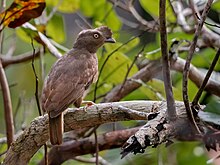| Guianan cock-of-the-rock | |
|---|---|

| |
| Male | |

| |
| Female | |
| Scientific classification | |
| Domain: | Eukaryota |
| Kingdom: | Animalia |
| Phylum: | Chordata |
| Class: | Aves |
| Order: | Passeriformes |
| Family: | Cotingidae |
| Genus: | Rupicola |
| Species: | R. rupicola
|
| Binomial name | |
| Rupicola rupicola (Linnaeus, 1766)
| |

| |
| Synonyms | |
|
Pipra rupicola Linnaeus, 1766 | |
The Guianan cock-of-the-rock (Rupicola rupicola) is a species of cotinga, a passerine bird from South America. It is about 30 cm (12 in) in length and weighs about 200 to 220 g (7.1 to 7.8 oz). It is found in tropical rainforests, near its preferred habitat of rocky outcrops. The female's plumage is brownish/dark smokey grey in colour, and generally less noticeable than the males because of their nesting work in rocky areas. The male's feathers are a bright orange. Both have a heavy body, broad-based bill and wear a remarkable half-moon crest on the head. It is one of two species of the genus Rupicola, the other being the Andean cock-of-the-rock. The Guianan cock-of-the-rock lives across the forested region of northeastern South America. Its diet consists mostly of fruit, but they sometimes feast on small snakes and lizards.
The Guianan cock-of-the-rock breeds in the early months of the year and, on average, the female lays her eggs around March. The females choose a mate by flying down to the ground and pecking the male on his rump. The male then turns around and the mating takes place almost immediately. During the height of the mating season, males engage in competitive displays in the lek, which is a complex courting behaviour that is done to attract females. Males and females live separately except when the females choose a mate. The mating success varies based on multiple factors, ranging from the plumage exhibited by a male to the composition of the lek itself. There is speculation that the male–male competition is an important factor in lek formation and breeding. The main predators of the Guianan cock-of-the-rock are harpy eagles and black-and-white hawk-eagles.
- ^ BirdLife International (2016). Rupicola rupicola. The IUCN Red List of Threatened Species 2016. doi:10.2305/IUCN.UK.2016-3.RLTS.T22700971A93807320.en
- ^ "Appendices | CITES". cites.org. Retrieved 2022-01-14.
